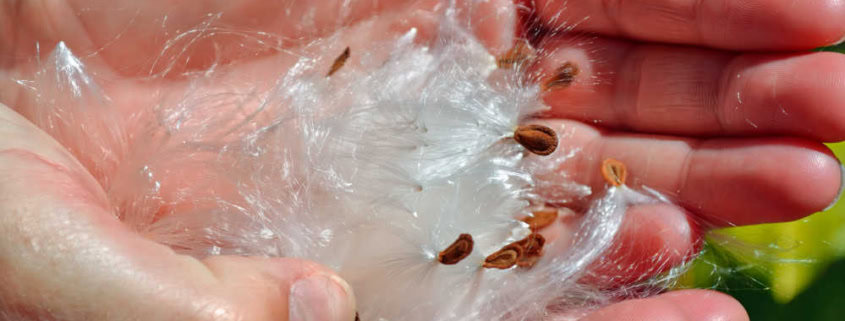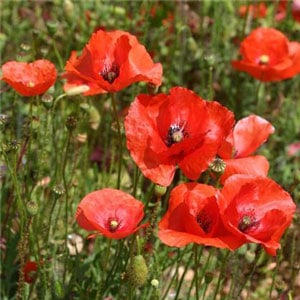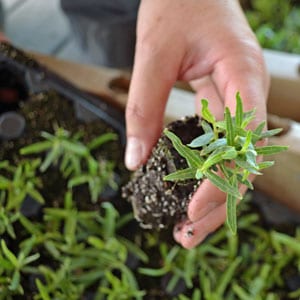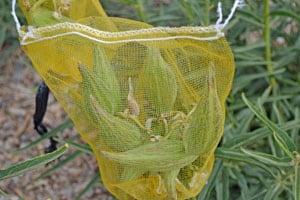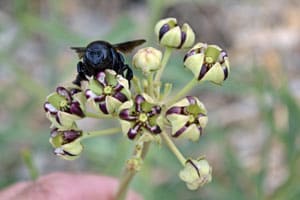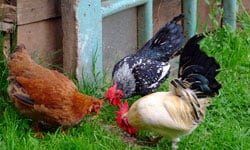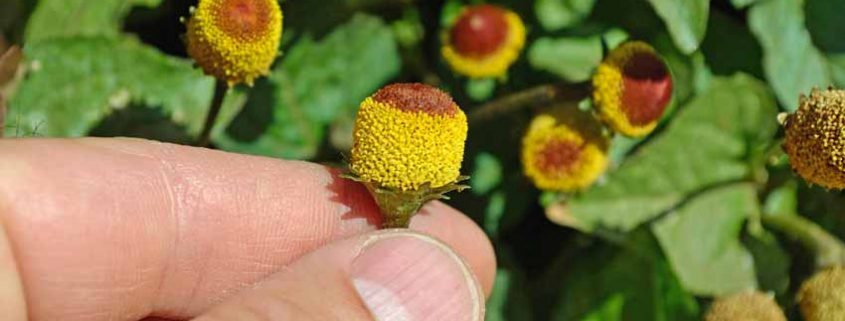Milkweed Seed Germination uses soaking and rinsing of the seeds to remove a naturally occurring chemical from the seed surface for better germination.
Tag Archive for: Flower Tips
The book “The Culture of Vegetables and Flowers from Seeds and Roots” by Suttons and Sons printed in 1910 had this to say about the poppy-
“The recent developments of this flower have brought it into great and deserved popularity, and it may be safely affirmed that no other subject in our gardens affords a more imposing display of brilliant colouring during the blooming period. All the varieties are eminently adapted for enlivening shrubbery borders and the sides of carriage-drives. Large clumps of some of the bolder colours should be sown in spots that are visible from a distance, and they will present glowing masses of flowers.”
What a beautiful description for a flower that has been cultivated for a long time. Here are a few gardening tips for the poppy:
- When selecting the perfect spot, remember that they love bright sunlight for most of the day. If you live in a hot climate, pick a spot that will be at least partially shaded during the heat of the afternoon.
- A well-drained spot is needed, as the poppy’s roots will rot in waterlogged soil, especially during the winter months.
- Enjoy poppies where you plant them, they do not make good cut flowers.
- Wood chip mulch around the base will help reduce weeds as well as help keep needed moisture at the roots.
- Deadhead, or remove the individual flowers as the blooms fade and wilt. Removing the spent blooms encourages the plant to keep blooming throughout the summer.
- When the flowers have died down for the season, cut back the foliage to the ground. This will produce a second showing of attractive summer leaves.
Many people associate poppy seeds with the familiar and wonderful array of Eastern European baked goods, from poppy seed pie or the poppy seed filling in the Purim holiday classic Hamantaschen. The Czech Republic is one of Europe’s largest producers of poppy seeds. When you harvest your seed pods from your garden you can make your own savory dishes featuring the poppy seeds.
Here is a perennial favorite that is easy to make and tastes so much better made at home, Poppy Seed Dressing!
Poppy Seed Dressing
- 2 tbsp. Poppy seeds
- 1/2 cup raw sugar
- 1/3 cup white wine vinegar
- 2 tsp. dry mustard powder
- 2 tsp. kosher salt
- 1 tsp. freshly ground black pepper
- 1 small yellow onion, finely grated, juice reserved
- 3/4 cup sesame oil
- 1/4 cup olive oil
- Heat a 2-qt. saucepan over medium-high heat. Add poppy seeds, and cook, swirling pan constantly, until lightly toasted and fragrant, about 3 minutes.
- Add sugar, vinegar, mustard, salt, pepper, and onion with juice, and cook, stirring constantly, until sugar dissolves and mixture begins to simmer.
- Remove from heat and transfer to a blender.
- Add both oils, and blend until smooth; chill.
Makes about 2 cups
Milkweed – Monarch Butterfly Food Source
As a small family owned heirloom seed company, we receive many requests for partnerships with or donations to some great causes. Some of these are exceptional, as when the Xerces Society contacted us in January 2012 about growing a specific species of milkweed that is native to our part of central Arizona. Pollinators and pollinator attractants are very important to the success of any garden, so we jumped at the chance to connect the right people who share our passion for this project. Here is how that story unfolds!
Monarch butterflies have seen steady population declines across their native range since population monitoring first began in 1976. Several 2012 reports show that Monarch numbers will drop almost 30 percent this year, continuing a decline that has lasted for the past decade. The severe drought seen across Texas and Northern Mexico, combined with wildfires across the entire southwest has been a large factor. The biggest contributor is simply the loss of land that supports the Monarch’s food source and hatchery – the Milkweed plant. Much of the land has been converted to commercial herbicide tolerant corn and soybean production, or developed into housing. Overuse of persistent chemical herbicides and roadside mowing for weed control has also created loss of milkweed habitat and thus reduced Monarch numbers.
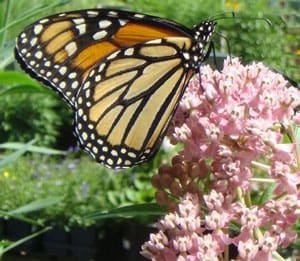
Monarch Butterfly on Milkweed
The milkweed plant (Asclepias spp.) plays a critical role in the monarch life cycle. Each spring Monarchs move across the United States, laying eggs on native milkweeds, the only plants that serve as food for newly hatched monarch caterpillars. Because of their migratory life cycle–breeding in the United States and Canada, and overwintering at only a few locations in Mexico and California–the most effective conservation strategies for Monarch butterflies are those that protect and restore habitat across their entire range. As a result, the North American Monarch Conservation Plan recommends planting native milkweed species to restore habitat within the Monarch butterfly’s breeding range.
The Xerces Society is working to increase the availability of native milkweed seed and encourage restoration using milkweed in California, the Great Basin, the Southwest, Texas, and Florida. These are important areas of the Monarch’s spring and summer breeding range where few commercial sources of native milkweed seed currently exist. To conduct the project, they are partnering with the Monarch Joint Venture, a coalition of federal and state agencies, scientists, and nonprofit conservation organizations.
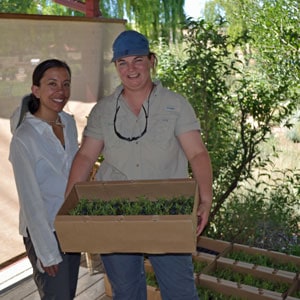
Brianna Borders and Cindy Scott with Milkweed plugs
At the end of this past January, we were contacted by Brianna Borders, Plant Ecologist for The Xerces Society about a possible project to propagate a subspecies of Milkweed – Asclepias asperula that is native to Arizona. She had about 2 ounces of seed (approximately 7,000 seeds) that had been collected in the southern portion of our local county by the Desert Botanical Garden volunteers in Phoenix. Through grant funding, a California native plant nursery could propagate the seeds into plugs ready for planting. The Xerces Society was looking for a grower in our area that could bring the project into being. This would be a minimum 2 year project to grow a commercial quantity of seed to offer for sale.
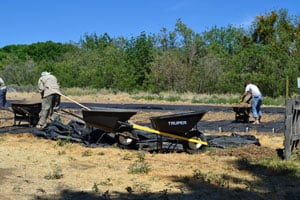
Spreading Mulch for Milkweed plugs
After some thought, we decided that Fiona Reid was the perfect fit for this project. Recently retired as Education Director from a natural history education center, she was already growing and saving milkweed seeds at her property – Painted Lady Vineyard! One of her passions is native plants of the area, with an emphasis on butterfly attractants, and has solid connections with the Arizona Native Plant Society, as well as the Desert Botanical Garden in Phoenix. The Painted Lady is a beautiful, ephemeral butterfly that happened to visit the vineyard in droves as the initial vines were being planted, thus the name for the vineyard came about.
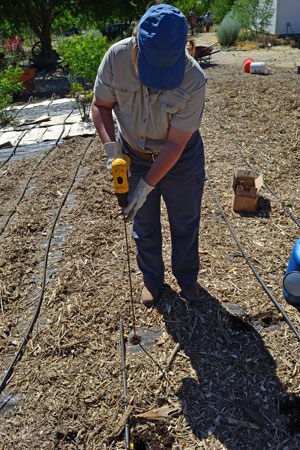
Drilling Holes for Milkweed Plugs
The planting took place over a long and extremely hot weekend in the middle of June after much work over many weeks not only by Fiona but her volunteer crew to prepare the ground to receive the fragile tiny plugs that had arrived overnight in flats from the grower in California. We took part in the planting, but what really inspired, amazed and humbled us was the outpouring of community support from all walks of life and all interests in this project that will only benefit the Monarch butterfly. There are no financial rewards for any of the volunteers for the hours spent bent over in 100 degree heat planting over 2,000 fragile plugs. Many of the people helping were native plant enthusiasts, some were butterfly lovers, but a significant number had no real interest besides that of helping see a project to fruition on nothing more than the basis of it is the right thing to do.

Planting Milkweed is a Team Effort
We received this email from Fiona on Monday after the planting weekend. When we left Saturday evening, a little over half of the plugs were planted. There was some concern of getting the rest planted with the remaining group and the high heat creating a deadline of viability for the milkweed plugs.
“Monday morning, after a pretty blazing hot weekend, and the little plants – ALL of them – are sitting in the ground, protected by mulch, and getting the necessary drink of water. Mission accomplished!
320 hours of volunteer labor, not even counting mine, to get this job done from start to finish. It has been an amazing community effort and I have had the pleasure of working with a great group of people, children included. As we began to close in on the finish yesterday, and everyone was hot and very dusty and sometimes muddy, I was almost overcome by the understanding that people don’t have to involve themselves in such hard work – sometimes backbreaking work, sometimes knee-breaking work, and always hot work. They could sit at home in the cool, or an office somewhere, and do good for someone else. But none of you did that. You came knowing it was going to be outside in the heat; knowing you would kneel and bend; knowing you would get dust in your nose and eyes; knowing that – as Rachel Carson said – “there is something beyond the bounds of our human existence” that matters. You also know that you won’t get any thanks from the butterflies that find all the little milkweed gardens that will eventually grow from this project. I do know, from the simple fact that you involved yourselves in this effort, that you will one day spot a monarch butterfly and in that fleeting moment there will be a part of your soul that stirs and feels absolute content. There is something right with the world – it may be ephemeral, and maybe you can’t articulate what it is, but that moment is enough for us.
I don’t think we will get a harvest this year at all. Next year we will have to put our heads together to figure out how we take the next step – collection of the seed. In the meantime I hope you can pat yourselves on the back for a fantastic job, so well done. I cannot thank you enough.”
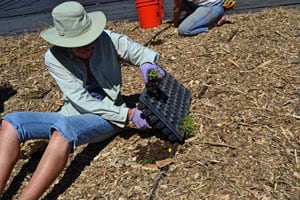
Planting Milkweed Plugs
Here’s Fiona’s update on the project after the Monsoon rains have begun:
“It’s what we have all been waiting for – the rains! Right now, as I look through my office window, there are heavy raindrops exploding like little bombs on the driveway, and I know they are doing just the same over the new milkweed fields less than a hundred yards away. Perhaps I should take this very opportunity to celebrate these first rains of the monsoon season and take off all my clothes and run over there and be like a little milkweed, totally open to the elements!”

Almost Half Way!
“2,190 milkweed plugs, grown from seed in a California greenhouse, are now at home in our native Skull Valley soil, barely 50 miles from their parent plants. And their roots are now moving out from the plug of soil which has been their ‘nest’ for so many months into the earth around them. These rains have showered them with nitrogen and freshness and their narrow leaves are pushing up towards the currently cloud covered sky. So I can pat myself on the back for a job well done, right? But nothing like this can happen without the help of others, so they all need a pat on the back as well.”
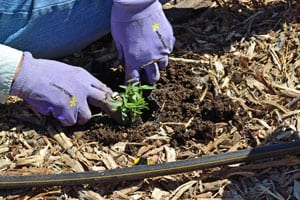
Busy Hands
“Community and connections make good things happen. Stephen and Cindy needed to think of me for this project; I needed Jodi Padgett, with whom I share life and land, to agree with the idea that we could plant the milkweed on the property; I needed to find someone to plough and level the planting areas; I needed volunteer help almost every step of the way. I needed Brianna Borders of the Xerces Society to support me when needed. Food and wine is usually a great incentive for volunteers, but that’s not all – realizing that there is, as Rachel Carson said, “something beyond the bounds of our human existence” worth paying attention to is probably more of an incentive for every single one of the volunteers who came and knelt, and dug, and laid weed barrier fabric, and connected irrigation parts, and invented hole-burners and augers, and finally, tenderly, popped these little milkweed plugs into the earth with a silent prayer that each one would grow strong. All of this work was done in unusually hot weather. The youngsters took much needed breaks by splashing around in the swimming pool; the elders sat in the shade gulping down iced mint tea. Everyone got hot, sweaty and very dusty.”

More Busy Hands
“And for the past month, as hot dry weather has continued to dominate our local area, I began and ended each day by watering those four blocks of milkweed. Today the rains did the watering for me, and moments ago, (fully clothed) I wandered around the blocks and, yes, all of a sudden it seems that these small plants have decided this is a good place to be and have sent their roots out into the native soil and are prepared to call this place ‘home’.
We don’t get paid dollars for doing this. What we get is priceless. One day, in many gardens around this area and scattered throughout the southwest, the most ephemeral of creatures – a butterfly – will lay her eggs on the milkweed that has been grown there especially for her, and the stunning caterpillar that emerges will have all the nourishment it needs right there. Soon thereafter, through the miracle of metamorphosis, a monarch butterfly will continue the northward journey. We may only get a fleeting glimpse of this whole cycle, but that’s OK – we just need, it seems, to know that we are part of a bigger whole that is life on earth.”
Very well said, Fiona!
July 2013 update:
It has been just over a year now, and things are looking very well indeed! We visited Fiona recently to see how the seed production was coming along, took some photos and video and wanted to share them with all of you.
There are several things that have been learned from this experience. First off, the milkweed is an on-going production plant, meaning that it doesn’t set all of its flowers at once. This means that there aren’t a crush of seed pods that need to be bagged (needing a crew or a bunch of hardy volunteers), but it does mean that there are little bunches of pods that always need bagging, so it is seemingly never done. Second, there is no real seed cleaning equipment available for the small scale grower to process and separate the seeds from the floss. There is equipment for the large seed grower that costs as much as some folks homes, but nothing for the smaller scale grower. We have known that as an heirloom seed company, as we’ve had to adapt other industry’s equipment and needs to serve our own. Third, there isn’t an established market for a regionally adapted milkweed seed of a specific species, as there hasn’t been any available up until this point in time.
Let’s look at how things have developed:
This is what a milkweed pod that has been bagged looks like. It is bagged to capture the “floss” or fluff that transports the seeds on the wind. This has to be done on an on-going basis, as the pods grow and begin to mature.
This is what good pollination will do for production, and really emphasizes the importance of all pollinators, but especially bees. Big black carpenter bees are what do the most effective pollination for Painted Lady Vineyard, as they get into the flowers and do a tremendous job that the smaller pollinators can’t.
This is one of the several butterflies that were visiting the milkweed the day we were there.
The star of the show appears: the carpenter bee!
Another view of this hard-working bee. Notice my hand in the background, holding the flower stalk steady as the wind was starting to pick up. The bee didn’t mind and let me get several close-up “glamour” shots! They are big enough to get down into the flower and do the pollination work that smaller insects just can’t reach. The flowers are quite stiff, and some insects will be damaged trying to get into these flowers as their legs get caught.
Here’s a short video showing what the field of milkweed looks like, as well as how Fiona and Brianna have worked together to determine how to separate the floss from the seeds.
Raising backyard chickens is becoming increasingly popular, no matter where you live. There have always been rural chickens, but now there are small and large city chickens, happily living in coops and backyards all across the country. Chickens can do a lot for you, both in the garden and in the kitchen. First off, they give you a real measure of food security and increase your resiliency. The eggs are a great bartering tool, as very few folks that we’ve talked to weren’t interested in some fresh home-raised eggs. Chickens are great for bug control, light soil tilling and fertilization. The chicken manure is very high in Nitrogen and is a great addition to your compost. Home raised eggs are some of the highest nutritional content of any chickens, including free-range. The reason is that most home raised chickens are pampered and given extra nutrition and care. It is very easy to provide a highly nutritious and healthy diet for your backyard chickens from your home garden. We will look at several heirloom vegetables, herbs and flowers that you can easily grow in your garden that will not only provide some tasty treats for your chickens, but give you some great greens as well.
Almost any of the greens and vegetables that you enjoy your chickens will love. You have probably seen them get really excited if you share salad fixings or old veggies from your refrigerator. Think of how they will get when they know that the garden is providing treats for them all of the time! You don’t have to plant a special garden just for the chickens, as they will happily devour any greens that come their way.
The question is often asked of why grow your chicken’s food, why not just buy the 50lb. bag of chicken scratch and call it good? There is nothing wrong with going this route, and realistically you will most likely need to have some commercial feed available as your garden may or may not produce enough greens and grains for your flock. This will vary depending on the size of your garden compared to the size of your flock. The real answer to growing fresh greens for your chickens is the same answer as to why you would want to grow your own garden- taste, nutrition and choice.
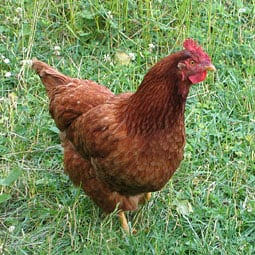
Spring Chicken
Let’s look at several varieties of vegetables and herbs that are easily grown in a home garden setting that will provide some tasty and highly nutritious greens for both you and your birds. Starting off in the cooler season with some cold-hardy greens will help jump-start the hens energy levels. Kale, Swiss Chard, mustard greens and beet tops are a great start to the season. They all like a cooler soil, sprout quickly and will provide some serious nutrition. Speaking of sprouting, sprouts are an absolute powerhouse of nutrition and are ready to eat in 4-7 days. Alfalfa sprouts are possibly the best known, but there are several different types of sprouts such as radish, mung bean and red clover that work well. Sprouts take up minimal space, use little water and need only the most basic equipment to produce a couple of pounds of fresh food. This is a technique that works especially well in the depths of winter when other greens are scarce and expensive. You can produce plenty of sprouts for yourself and a half dozen chickens from a half gallon jar with a sprouting screen lid on your kitchen sink.
Once the weather starts warming up more options open up for different vegetables and greens. Cabbage, chicory, mustards, spinach and a number of greens do well in the early spring once the soil has started warming up. These include Miner’s Lettuce, French Purslane and Aztec Red Spinach. Once the true spinach starts to bolt in the warmer weather, switch to the spinach substitutes such as red and green malabar spinach, the Aztec Red spinach and New Zealand spinach. All of these love the heat, won’t bolt and produce all through the hotter weather. Traditional winter cover crops such as alfalfa, clover, vetch and annual rye should be considered for later in the year.
If you have the space, pumpkins and squash- both summer and winter- can be excellent feed choices. Winter squash and pumpkins that can be stored until later in the winter give you an additional resource for high quality feed when nothing else is growing. Corn is another great choice, space permitting, as it is the base for the commercial feeds. Other grains that will grow well in a smaller home garden set up is Mennonite Sorghum, Amaranth and Quinoa. Don’t forget Sunflowers, as they can provide both shade and a wind break for your garden along with seeds for your girls.
Many folks don’t think of herbs when it comes to providing food for chickens, but there are some great choices here. Borage is one such, as it has lots of mineral-rich leaves as well as flowers that are edible and make excellent additions to a chicken’s diet. Comfrey is in the Borage family and is another great choice.
To help you get started, we have created a section on our website called “Backyard Chickens Collection”, appropriately enough. We list all of the varieties that are mentioned in this article to save you the time of looking throughout the website to find them. It is really easy to incorporate the chicken feed aspect into your existing gardening plan. Planting one or two extra plants of each variety for each half dozen chickens is usually sufficient, with grains such as Amaranth and sunflowers going almost exclusively to the chickens. As with most things gardening related, a little experimentation will prove the way as you see what volumes of fresh garden produce you particular flock of chickens needs.
Szechuan Buttons – Secret Ingredient of Celebrity Chefs and Master Bartenders
One of our best selling herbs is the Toothache Plant or Szechuan Buttons. Spilanthes oleracea, also known as Acmella oleracea is a low-growing plant with bronze-purple leaves hosting yellow/red “gumdrop” flowers that bloom repeatedly summer through fall. The medicinal uses of spilanthes have been around for a long time. A mouth rinse of spilanthes extract can be used daily to promote gum health. In vitro testing has shown that the plant’s extract has strong effect against E.coli, pseudomonas, salmonella, klebsiella pneumonae and staphylococcus albus, as well as inhibiting the growth of candida albicans. Improves digestion, eases flatulence, improves the appetite, and helps to overcome nausea and vomiting by its stimulating effect on the salivary glands.
We don’t sell spilanthes soleley for its medicinal properties but also for its “Rock Star” qualities. NPR has a story about using the Szechuan Buttons in high-end restaurants and bars. The Washington Post did one as well. We were very intrigued and had to grow these amazing little plants last summer to see for ourselves, had a nibble of the traditionally used leaves and it makes your mouth tingle. It is like the old pop rocks candy, a very effervescent feeling. The fresh buttons sell for somewhere around $40 for a bag of 30 buttons, but if you grow them yourself it’s around $3.50 for a packet of 30 seeds, and you’ll grow hundreds of buttons! Freezing does not hurt their buzz, so you can have them year round.
We also had to try out the buttons on a cocktail. What follows is a short photo essay of this experience. We would highly recommend growing the plant for its rock star presence but also for the beauty it adds to the garden.
Starting with this –

Szechuan Buttons in the garden
We selected three great specimens.
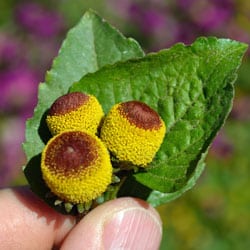
Szechuan Buttons ready for use
With the ingredients gathered, we were ready to start.

All ingredients are ready
After the drink is made, the magic is ready to be put into play! The Buttons must be pressed into the rim of the glass firmly, as the bud needs to be slightly crushed to release the “Buzz”.
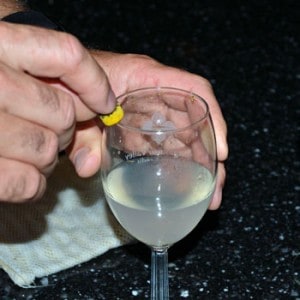
Szechuan Buttons in action
We were surprised at the strength of the tingle and how long it lasted. Any part of our mouths or tongues that touched the rim of the glass had an immediately noticeable tingling or buzzing feeling, along with some numbness of the tongue that lasted at least 20 minutes. The height of the effect easily lasted 10-12 minutes, with a slow tapering off toward the end.
Seeing how easy it is to grow these, you can be the producer of a lot of “Buzz”!

